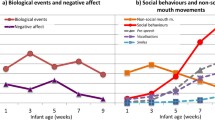Summary
Although the beginning of postpartum social integration and communication has been long viewed as relevant to psychiatric theories, early parent-infant communication has become a matter of scientific investigation only recently. The present survey explains the significance of an approach based upon the general systems theory and explores to what extent the early parent-infant interaction can function as a didactic system to support the development of thought and speech. Evidence of this function has been found in those forms of parental behavior that escape the parent's conscious awareness and control, as exemplified in the vocal communication with presyllabic infants. Parents unknowingly adjust the structure and dynamics of speech to the constraints of infant capacities, detach prosodic musicality from lexical structure, and use it in particularly expressive forms for the delivery of the first prototypical messages. In this and other similar ways, parents offer an abundance of learning situations in which infants can try out various integrative operations.
A biological rather than cultural provenience of the support of communicative development indicates a potential relevance for the interpretation of speech evolution. In addition to qualities of the vocal tract and to complex symbolic capacities in humans, the early intuitive support of communicative development and its playful character are suggested as species-specific determinants of speech evolution. Implications for clinical research are suggested.
Similar content being viewed by others
References
Bertalanffy L von (1968) Organismic psychology theory. Clark University Press with Barre Publishers, Barre
Bornstein MH, Ruddy MG (1984) Infant attention and maternal stimulation: Prediction of cognitive and linguistic development in singletons and twins. In: Bouma H, Bouwhuis DG (eds) Attention and performance X: Control of language processes. L. Erlbaum Associates, London, pp 433–445
Comenius JA (1657) Opera didactica omnia. Amsterdam
Fernald A, Simon T (1984) Expanded intonation contours in mothers' speech to newborns. Dev Psychol 20:104–113
Field T, Pawlby S (1980) Early face-to-face interactions of British and American working- and middle-class mother-infant dyads. Child Dev 51:250–253
Goldberg S (1977) Infant development and mother-infant interactions in urban Zambia. In: Leiderman PH, Tulkin SR, Rosenfeld A (eds) Culture and infancy: Variations in the human experience. Academic Press, New York, pp 211–243
Huizinga J (1955) Homo ludens. Beacon Press, Boston
Jacobson JL, Boersma DC, Fields RB, Olson KL (1983) Paralinguistic features of adult speech to infants and small children. Child Dev 54:436–442
Janoš O (1959) Development of higher nervous activity in premature infants. Pavlov J Higher Nerv Activ 9:760–767
Kagan J, Klein R (1973) Cross-cultural perspectives on early development. Am Psychol 28:947–961
Lipsitt LP (1982) Infant learning. In: Field TM, Huston A, Quay HC, Troll L, Finley GE (eds) Review in developmental psychology. J Wiley, New York, pp 62–78
Meltzoff AN (1981) Imitation, intermodal co-ordination, and representation in early infancy. In: Butterworth G (ed) Infancy and epistemology. Harvester Press, Brighton, pp 85–114
Meltzoff AN, Moore MK (1977) Imitation of facial and manual gestures by human neonates. Science 198:75–78
Ninio A (1980) Picture-book reading in mother-infant dyads belonging to two subgroups in Israel. Child Dev 51:587–590
Papousek H (1967) Experimental studies of appetitional behavior in human newborns and infants. In: Stevenson HW, Hess EH, Rheingold HL (eds) Early behavior: Comparative and developmental approaches. J Wiley, New York, pp 249–277
Papoušek H (1977) Entwicklung der Lernfähigkeit im Säuglingsalter. In: Nissen G (ed) Intelligenz, Lernen und Lernstörungen. Springer, Berlin Heidelberg New York, pp 75–93
Papoušek H, Papoušek M (1982a) Infant-adult social interactions: Their origins, dimensions, and failures. In: Field TM, Huston A, Quay HC, Troll L, Finley GE (eds) Review in developmental psychology. J Wiley, New York, pp 148–163
Papoušek H, Papoušek M (1982b) Integration into the social world: Survey of research. In Stratton P (ed) Psychobiology of the human newborn. J Wiley, New York, pp 367–390
Papoušek H, Papoušek M (1982c) Vocal imitation in mother-infant dialogues. Presentation at the 3rd Int Conf Infant Stud, Austin, Texas. Infant Behav Dev 5 (Special ICIS Issue): 176 (Abstract)
Papoušek H, Papoušek M (1984) Learning and cognition in the everyday life of human infants. In: Rosenblatt JS, Beer C, Busnel C-M, Slater PJB (eds) Advances in the study of behavior, vol 14. Academic Press, New York, pp 127–163
Papoušek H, Papoušek M (1985) The evolution of parent-infant attachment: New psychobiological perspectives. In: Call JD, Galenson E, Tyson RL (eds) Frontiers of infant psychiatry, vol II. Basic Books, New York, pp 276–283
Papoušek M, Papoušek H (1981) Musical elements in the infant's vocalization: Their significance for communication, cognition, and creativity. In: Lipsitt LP, Rovee-Collier CK (eds) Advances in infancy research, vol 1. Ablex Publ Corp, Norwood NJ, pp 163–224
Papoušek M, Papoušek H, Bornstein MH (1985) The naturalistic vocal environment of young infants: On the significance of homogeneity and variability in parental speech. In: Field TM, Fox NA (eds) Social perception in infants. Ablex Publ Corp, Norwood NJ, pp 269–297
Rheingold HL, Adams JL (1980) The significance of speech to newborns. Dev Psychol 16:397–403
Sameroff AJ, Cavanaugh PJ (1979) Learning in infancy: A developmental perspective. In Osofsky JD (ed) Handbook of infant development. J Wiley, New York, pp 344–392
Stern DN, Spieker S, MacKain K (1982) Intonation contours as signals in maternal speech to prelinguistic infants. Dev Psychol 18:727–735
Tulkin SR, Kagan J (1972) Mother-child interaction in the first year of life. Child Dev 43:31–41
Warren-Leubecker A, Bohannon JN III (1984) Intonation patterns in child-directed speech. Child Dev 55:1379–1385
Author information
Authors and Affiliations
Additional information
The research concerning this topic has kindly been supported by Die Deutsche Forschungsgemeinschaft (Grant Pa 208/4-2).
Rights and permissions
About this article
Cite this article
Papoušek, H., Papoušek, M. Structure and dynamics of human communication at the beginning of life. Eur Arch Psychiatr Neurol Sci 236, 21–25 (1986). https://doi.org/10.1007/BF00641053
Received:
Issue Date:
DOI: https://doi.org/10.1007/BF00641053




